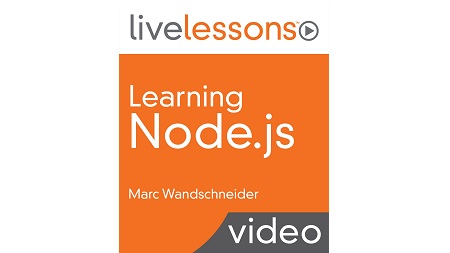
English | MP4 | AVC 1280×720 | AAC 44KHz 2ch | 16 Hours | 4.8 GB
A clear, practical introduction to the important new web development technology for creating web server applications in JavaScript
Learning Node.js LiveLessons provides developers with a practical introduction to Node.js, an important platform for developing web and network applications.
In this video training, Marc starts by introducing Node.js, installing, and running it. The video then moves into writing JSON servers, web applications, client-side templates, and continues by covering database access to both SQL and NoSQL database servers.
After watching this video, developers will begin to understand why Node.js inspires so much passion, and they will be able to write fast, compact, and reliable applications and web server.
The second edition updates coverage of Node.js to reflect changes in the technology and how it is used in the three years since the first edition was published:
- Explanation of Node’s new versioning scheme
- Updated coverage of Streams
- New coverage of installation using pre-build installers rather than from source code
- New coverage of Mongoose in the section on MongoDB
- New information about deploying Node on Heroku and Azure
- Expansion of coverage on testing
What You Will Learn:
- Why Node is really exciting
- How Node is hugely innovative and new
- How not to be afraid of JavaScript and indeed how to embrace it
- How to write fast, compact, and reliable application and web servers
- How to stay up to date with the latest in web application design and techniques
Table of Contents
Introduction
Learning Node.js: Introduction
Getting Started
1.1 Install Node.js
1.2 Figure out all these version numbers
1.3 Write “Hello World!” in Node.js
1.4 Run your first web server
1.5 Use the Node.js debugger
1.6 Stay up to date and find the help you need
A Closer Look at JavaScript
2.1 Use basic types
2.2 Use strings
2.3 Use objects
2.4 Use arrays
2.5 Make full use of functions
2.6 Use language constructs
2.7 Write classes with prototypes and inheritance
2.8 Use and handle errors
2.9 Work with two important Node.js globals
2.10 Play with a couple of new JavaScript features
Asynchronous Programming
3.1 Compare synchronous and asynchronous programming
3.2 Mix error handling and asynchronous programming
3.3 Solve a new problem that arises in Node.js—losing your “this” reference
3.4 Yield control and improve responsiveness
3.5 Take a quick look at synchronous programming in NodeJS
Writing Applications
4.1 Write your first JSON server
4.2 Combine loops and asynchronous programming
4.3 Support multiple request types in your server
4.4 Explore requests and responses
4.5 Add support for query (GET) parameters
4.6 Receive POST data
Modules
5.1 Write a simple module
5.2 Use npm—the node package manager
5.3 Write a more interesting module
5.4 Publish modules
5.5 Explore the async module, a vital component of our apps
5.6 Make sure to keep your promises
Expanding our Web Server
6.1 Investigate Node.js streams
6.2 Serve static files from our server
6.3 Serve different file types with our server
6.4 Use HTML templates—the basics
6.5 Use HTML templates—the Mustache framework
6.6 Use HTML templates—bootstrapping the process with JavaScript
6.7 Use HTML templates—final assembly for the browser
Building Web Applications Easier with Express
7.1 Install Express and write Hello World
7.2 Route requests
7.3 Update your app for routing
7.4 Understand REST API design
7.5 Factorize your code with modules
7.6 Explore Express middleware
7.7 Clarify the importance of ordering in middleware
7.8 Replace static file handling in the app with middleware
7.9 Support POST data, cookies, and sessions
7.10 Upload files
7.11 Support authentication in NodeJS.
Databases I—Mongodb and Node.js
8.1 Set up and run Mongodb
8.2 Perform basic Mongodb operations
8.3 Query collections with the “find” method
8.4 Update your photo app—setting everything up
8.5 Add the new database operations to the app
8.6 Add new pages and templates to the app
Databases II—MySQL
9.1 Prepare MySQL
9.2 Create a SQL schema for our project
9.3 Learn about core database operations in MySQL
9.4 Look at our updated application with MySQL
9.5 Add authentication to our app—API and handlers
9.6 Add authentication to our app—pages and templates
Development and Deployment I: Rolling our own.
10.1 Deploy Node apps: Basic
10.2 Deploy Node apps: Ninja (Unix-like)
10.3 Deploy Node apps: Ninja (Windows)
10.4 Fully take advantage of multi-processor servers on deployment
10.5 Support sessions on multiple servers with memcached
10.6 Implement virtual hosting—Express
10.7 Implement virtual hosting—proxy servers
10.8 Secure your projects with HTTPS—Express
10.9 Secure your projects with HTTPS—proxy servers
10.10 Develop for multiple platforms
Command-Line Programming and Scripting
11.1 Run command-line scripts (Unix-like)
11.2 Run command-line scripts (Windows)
11.3 Use synchronous file APIs
11.4 Understand the basics of stdin/stdout
11.5 Launch processes with the “exec” function
11.6 Launch processes with the “spawn” function
Development and Deployment II: Working with Heroku and Azure
12.1 Get ready to deploy to Heroku
12.2 Deploy your app to Heroku
12.3 Look at tools to help with developing on Heroku
12.4 Get ready to deploy on Microsoft Azure
12.5 Deploy your app to Azure
12.6 Look at tools to help you developing on Azure
Testing
13.1 Explore some testing framework options and install nodeunit
13.2 Write your first nodeunit tests
13.3 Handle asynchronous programming in your tests
13.4 Write blackbox tests for your API server
Summary
Learning Node.js: Summary
Resolve the captcha to access the links!